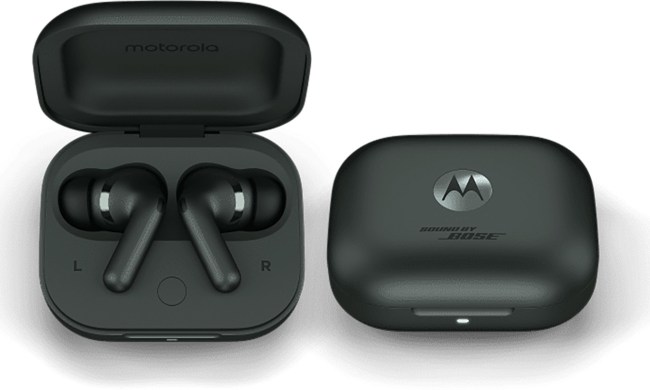- Superior noise-canceling system; very comfortable; good frequency response
- High price may trouble some; not the ultimate solution for audiophiles
Summary
Here’s today’s quiz—guess how many headphones will be bought in the U.S. this year? If you said 68 million, you’d win the prize. The vast majority are earbuds for music players with a chunk (12 million) the classic wired-headband, DJ-wannabe style cans. A much smaller portion of these are noise-canceling type, the kind that shuts out the outside world and lets you concentrate on the music, soundtrack or whatever you’re listening to. Bose, the venerable audio company, really made this latter type of headphone popular and its classic QuietComfort 2 model is frequently spotted on dozing airplane passengers. The QC2’s – originally introduced in 2003 – hadn’t been upgraded since 2005, however. So Bose researchers sealed themselves in a lab and came up with the QuietComfort 15. After settling into an airline seat, it was our turn to try them out…
Features and Design
The Bose QuietComfort 15 Acoustic Noise Canceling headphones have a circum-aural design which means they fit over your ears; they don’t rest on them (supra-aural) or get plugged in like earbuds. Will you look dorky walking around with them on your head? Of course, but you really don’t want to run or bike outdoors with noise-canceling headphones for safety’s sake. Walking around in a plane is very cool though (more on this in the Performance section).

The headphones don’t look that much different than the originals, which we wore on many flights. And if you’re looking for edgy Skullcandy-type styling and colors, forget it (see photos). Primarily black (see the cushions, headband) the exterior of the cups are silver with the shiny metallic edging featuring Bose logos in the center. By comparison, the original QuietComfort 2’s have a much duller appearance. The right cup hosts the on/off switch, indicator light and slot for the AAA battery which powers the system. The most critical difference, other than some aesthetic points, are the pinhole mics found in the QC15’s shiny metallic edging. These microphones measure ambient noise and adjust the noise-canceling circuitry to eliminate as much extraneous sound as possible. On the left earpiece is a slot for the supplied cable which plugs neatly into it. We can get into the minutia of the padding materials, but why bother – they’re simply comfortable wired, over-the-ear headphones.
What’s In the Box
You get a streamlined carrying case, the headphones and detachable cable with the standard 3.5mm connector. The kit also has an airplane adaptor (two prong), AAA battery, quick setup page and a multi-language owner’s manual (8 pages in English).

Performance and Use
Is there anything simpler to operate than a pair of noise-canceling headphones? Once the battery is inserted, you simply turn the power on, adjust the headband and settle in. We did that for very long stretches on 6- and 9-hour flights to Berlin traveling to the IFA electronics show.
First off, let’s state the QC15’s are extremely comfortable, with improved padding compared to the QC2. We hardly ever adjusted them during the flights, which is impressive given these traveling stretches’ duration. More important, the noise-canceling capability was far better than found in the older models. Flicking the headphones on was like turning off a lamp. Instead of the room going dark though, the roar of jet engines and screaming kids was blissfully blocked. This improvement was demonstrably better than prior models. Just as critical, frequency response—the range of tones you hear—was improved as well. During the flight we had our old iPod Classic running for hours and heard instruments in favorite tracks much more distinctly. The same held true for DVD soundtracks from a HP laptop. We also tried listening to the airline entertainment system, but it was so filled with distortion as to be unlistenable. (Sometimes accurate headphones aren’t such a good thing.) And for those sitting on the aisle, the cable easily disconnects so you can stand up without carrying your music player.

Overall, using these headphones was a pleasure, but there was one quirk worth bearing in mind. Specifically, the fact that attentive flight personnel kept asking whether our headphones were off or on during takeoffs and landings. We dutifully complied, but it would make life a lot easier for everyone if the power indicator light was on the left ear cup so passengers needn’t be bothered.
Conclusion
The best noise-canceling headphones we’ve used thus far are Sony’s more expensive MDR-NC500D ($399) model. Overall, these units have a wider dynamic range, but the QuietComfort 15 unit does a better job blocking out extraneous noise, a critical requirement for keeping your sanity while flying. Given that, we heartily recommend the QC15 for travelers who want comfortable, high-quality headphones. Admittedly, the price is a bit high to recommend them as a must-have purchase. Still, you’ll be more than happy with the unit’s performance should you choose to shell out for it.
Pros:
- Superior noise-canceling system
- Very comfortable
- Good frequency response
Cons:
- High price may trouble some
- Not the ultimate solution for audiophiles



